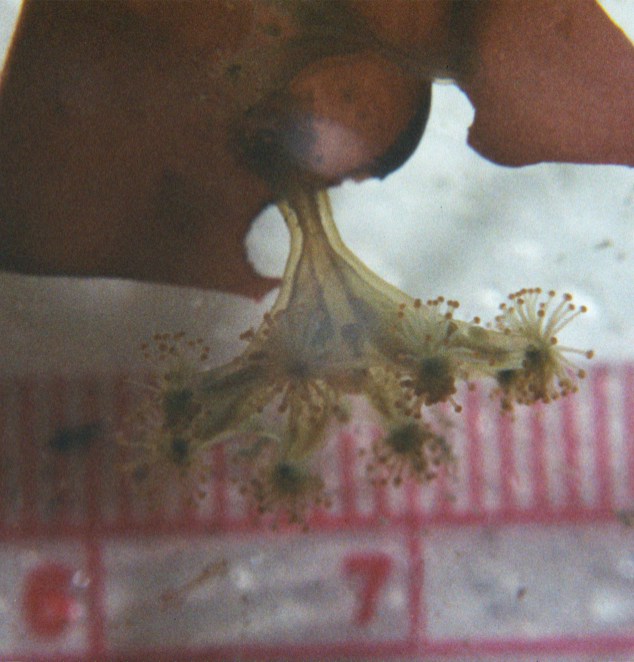Haliclystus sp.Common name(s): Stalked jellyfish |
|
| Synonyms:
Haliclystus auricula Haliclystus octoradiatus Haliclystus sanjuanensis Haliclystus stejnegeri |
 |
| Phylum Cnidaria
Class Scyphozoa Order Stauromedusae Family Haliclystidae |
|
| Haliclystus stejnegeri attached to a red algal blade | |
| (Photo by: Dave Cowles, July 2004) | |
How to Distinguish from Similar Species: Haliclystus salpinx has broad trumpet-shaped anchors with conspicuous stalks, and its gonads extend into the lobes for only about half their length. It is primarily an Atlantic species and appears to have only very limited distribution (or is a separate species) in the San Juan Islands in the Pacific.
Note: Hirano (1997) concluded that this stalked jelly, found from at least British Columbia to California, is an undescribed species. It has been called many things, including H. stejnegeri and H. auricula. It matches most closely with H. sanjuanensis (Gellerman, 1926), but that name cannot be used because it was in a manuscript that was never published.
Geographical Range: Alaska to Puget Sound; Japan
Depth Range: Low intertidal and subtidal
Habitat: Usually found on blades of kelp or eelgrass.
Biology/Natural History: Feeds on small crustaceans. Eaten by Calliostoma annulatum snail. This animal is a true medusa (jellyfish). It can glide along on the base of the stalk (which is the center of the exumbrella), contract the stalk or fold the calyx of the umbrella. If it becomes detached it clings to the substrate with the tentacles until the disk can reattach. It is not a good swimmer. Spawns in the summer in the San Juans, producing tiny 35 micron eggs. Eggs develop into a creeping, non-ciliated, wormlike larva which settles after a few days and develops its first nematocysts within a week. Juveniles may be able to encyst and overwinter.
| Return to: | |||
| Main Page | Alphabetic Index | Systematic Index | Glossary |
References:
Dichotomous Keys:
Carlton,
2007
Kozloff 1987, 1996 (as H. stejnegeri)
General References:
Kozloff,
1993 (as H. stejnegeri)
O'Clair
and O'Clair, 1998 (as H. stejnegeri)
Wrobel
and Mills, 1998
Scientific
Articles:
Gellerman, M.P., 1926. Medusae of the San Juan
Archipelago.
M.S. Thesis, University of Washington. 100 pp.
Hirano, Y.M., 1997. A review of supposedly
circumboreal species
of stauromedusa, Haliclystus auricula (Rathke,
1806). Pp.
247-252 in Proceedings of the 6th International Conference on
Coelenterate
Biology, 1995.
Web Pages:
Claudia Mills' web page: http://faculty.washington.edu/cemills/Staurolist.html
General Notes and Observations: Locations, abundances, unusual behaviors:
Authors and Editors of Page:
Dave Cowles (2004): Created original page